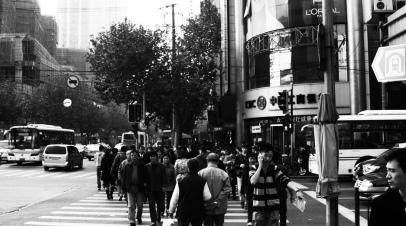
The alarm rings, I start my day with a shower, followed by a walk to the metro station. Afterwards I pick up my latte from the local Starbucks, a sandwich from the shop down the street, and I sit down and start my work for the day. After settling down in Shanghai, I have started to come into a more structured lifestyle. After exploring the city for a couple of weeks, I have found things I like and don’t like, and places where I feel at ease. What is interesting is that even in a foreign country I have been able to find comfort with a schedule. By following my schedule, I have found my own unique locations, and nodes within a city.
Finding these nodes provide great comfort and belonging especially in Shanghai, one of the largest cities in the world. Nodes are what allow the mega metropolis to become smaller, not necessarily talking in a physical sense, but rather in a mental sense. These nodes provide reoccurrences that start to become habitual. Reoccurrences like pushing my way into the subway train, recognizing menu items, and coffee house baristas memorizing my drink order (even in Shanghai, I know I have a problem). Similar characters start to show up in my daily narrative, like the girl who always sits in the corner, or the guy with the brief case who passes me on the street. By starting to create my own routine, my narrative starts to be played out within the city, I have started to realize other’s habitual patterns as well.
Habitual patterns start to become constant inputs. By tracking the quantitative data such as the number of people on the subway, and comparing this information with a timeline, the complexity of the urban fabric can really start to be picked apart layer by layer. As technology gets stronger, our ability to analyze habitual patterns becomes more sophisticated. With better understanding of movement and patterns, a city that can react and respond to our various inputs, doesn’t sound to ridiculous. For example, looking at street traffic, typically there is the same number of lanes on both sides of the highway, but many times both sides are not fully utilized at the same time. Rush Hour typically creates heavier traffic congestion going into the city in the morning hours, and leaving the city in the evening hours. A response to this could be flexible highway lanes that allow change in traffic flow direction at different hours.
This understanding of synchronized movement becomes an essential factor for understanding a cities urban fabric. The city is not only the physical built environment and occupation of people, but it also consists of moving through the spatial construct and moving through time itself. Currently urban design and the built environment has become a very rigid understanding of solid and void. This relationship has given character to many different cities, and has been the initial stages of defining our metropolises in order to deal with stasis and mobility. This idea is further analyzed in walking in the city, where the article starts to analyze how the built interacts with these patterns of human interaction, “Your path in a city is controlled by the cities order. Whether be through streets that are layered in an organizational grid, or even the negative spaces created by this grid pattern, in some way or another the urbanism organizes people”. With populations on the rise, in most major cities, and China in specific, we have to start to analyze how cities can be better organized, or more efficiently planned for people’s interaction with the built fabric.
Through past analysis of major urban morphology, one way that cities dealt with population increases was by building upward. New York and Chicago were the first cities to really start to explore the potentials of verticality with the skyscraper. These giant towers of stasis started to contain the expanding population, and found a way to combat sprawl with density. This has started to become one of the major problems with moving around the city, because we have vertically stacked the nodes within the city, but have constrained the means of moving from node to node. As these towers empty out at the end of the day, people flood the streets in a hurry to get to their next location, and as mentioned earlier everyone is always seeking location. Since the location has the ability to be rented, there is more emphasis on how the location is built rather than investing in the means of getting to that location.
In order for density to become a viable and sustainable model, the numbers have to be put into consideration, and the city has to become more flexible. The traditional model of the ground plane being the sole provider for transportation is simply just not going to be enough infrastructure to support the vertical density being sought out by rapidly developing countries. Cities need to advance their spatial understanding, and analyze how layering could really start to promote better fluid circulation. By habitual patterns analyzing and parametrically designing the built environment, the city will be able to respond and react to its occupants various inputs. With effort, the urban environment can start to not only become the container of people; rather it could take a more active role with the ever-increasing demands of its occupants. When the city starts to respond to its people the idea of a living city starts to come into play, and in my opinion will become the future of urbanism. We are not just talking about flying cars anymore, what we are talking about is a city that can morph and respond as a flexible solution to its users.
Ross Renjilian
Filed under: Architecture, City, Flexible, Growth, Habitual, Infrastructure, patterns, population, Renjilian, Ross, Urbanism, Urbanism


